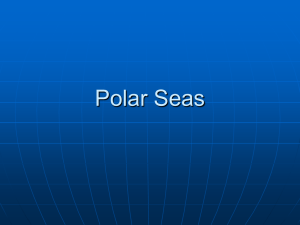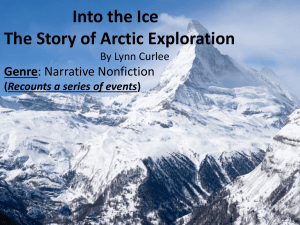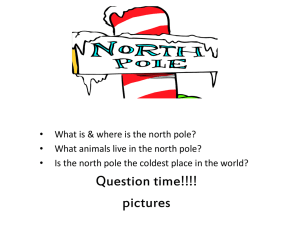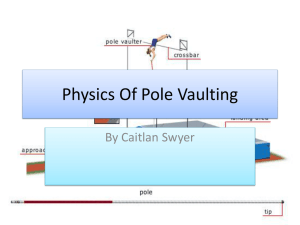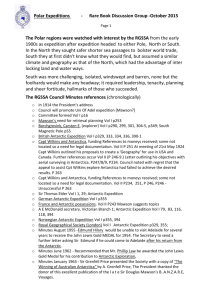THE EUROPEANS IN THE WORLD POPULATIONS
advertisement
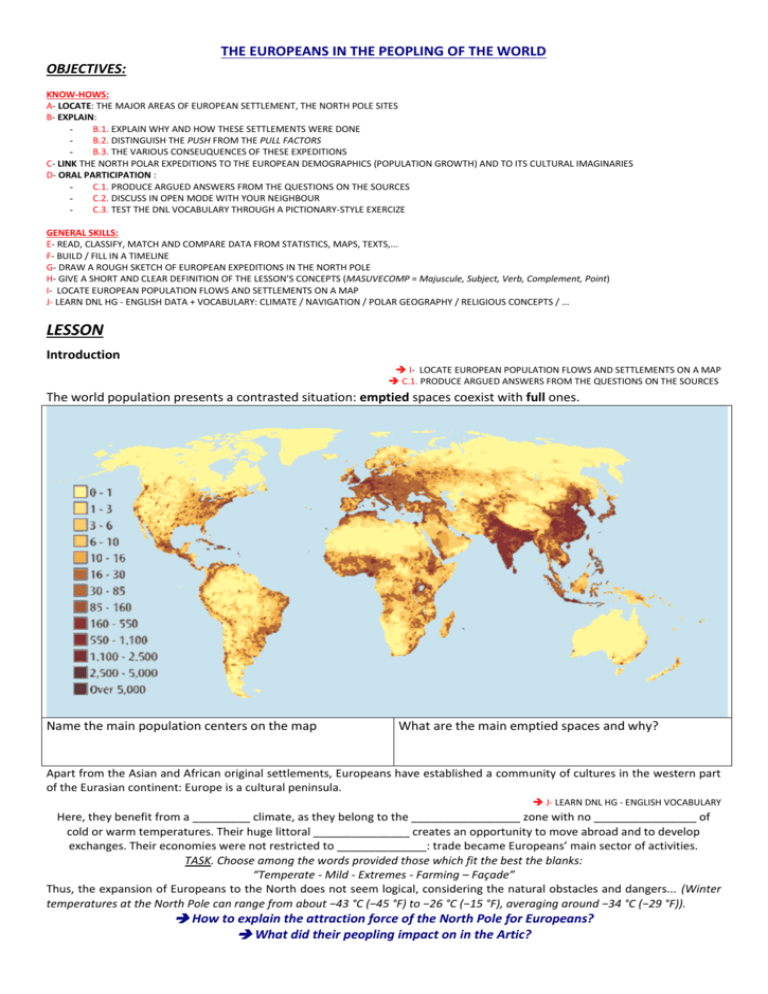
THE EUROPEANS IN THE PEOPLING OF THE WORLD OBJECTIVES: KNOW-HOWS: A- LOCATE: THE MAJOR AREAS OF EUROPEAN SETTLEMENT, THE NORTH POLE SITES B- EXPLAIN: B.1. EXPLAIN WHY AND HOW THESE SETTLEMENTS WERE DONE B.2. DISTINGUISH THE PUSH FROM THE PULL FACTORS B.3. THE VARIOUS CONSEUQUENCES OF THESE EXPEDITIONS C- LINK THE NORTH POLAR EXPEDITIONS TO THE EUROPEAN DEMOGRAPHICS (POPULATION GROWTH) AND TO ITS CULTURAL IMAGINARIES D- ORAL PARTICIPATION : C.1. PRODUCE ARGUED ANSWERS FROM THE QUESTIONS ON THE SOURCES C.2. DISCUSS IN OPEN MODE WITH YOUR NEIGHBOUR C.3. TEST THE DNL VOCABULARY THROUGH A PICTIONARY-STYLE EXERCIZE GENERAL SKILLS: E- READ, CLASSIFY, MATCH AND COMPARE DATA FROM STATISTICS, MAPS, TEXTS,... F- BUILD / FILL IN A TIMELINE G- DRAW A ROUGH SKETCH OF EUROPEAN EXPEDITIONS IN THE NORTH POLE H- GIVE A SHORT AND CLEAR DEFINITION OF THE LESSON’S CONCEPTS (MASUVECOMP = Majuscule, Subject, Verb, Complement, Point) I- LOCATE EUROPEAN POPULATION FLOWS AND SETTLEMENTS ON A MAP J- LEARN DNL HG - ENGLISH DATA + VOCABULARY: CLIMATE / NAVIGATION / POLAR GEOGRAPHY / RELIGIOUS CONCEPTS / ... LESSON Introduction I- LOCATE EUROPEAN POPULATION FLOWS AND SETTLEMENTS ON A MAP C.1. PRODUCE ARGUED ANSWERS FROM THE QUESTIONS ON THE SOURCES The world population presents a contrasted situation: emptied spaces coexist with full ones. Name the main population centers on the map What are the main emptied spaces and why? Apart from the Asian and African original settlements, Europeans have established a community of cultures in the western part of the Eurasian continent: Europe is a cultural peninsula. J- LEARN DNL HG - ENGLISH VOCABULARY Here, they benefit from a _________ climate, as they belong to the _________________ zone with no ________________ of cold or warm temperatures. Their huge littoral _______________ creates an opportunity to move abroad and to develop exchanges. Their economies were not restricted to ______________: trade became Europeans’ main sector of activities. TASK. Choose among the words provided those which fit the best the blanks: “Temperate - Mild - Extremes - Farming – Façade” Thus, the expansion of Europeans to the North does not seem logical, considering the natural obstacles and dangers... (Winter temperatures at the North Pole can range from about −43 °C (−45 °F) to −26 °C (−15 °F), averaging around −34 °C (−29 °F)). How to explain the attraction force of the North Pole for Europeans? What did their peopling impact on in the Artic? 1. MAP OF THE MAIN ARCTIC LOCATIONS A- LOCATE: THE MAJOR AREAS OF EUROPEAN SETTLEMENT, THE NORTH POLE SITES With the help of the Atlas provided, neatly locate the following locations: GREENLAND CANADA NORWAY RUSSIA ELLESMERE ISLAND: 1 SEA OF LABRADOR: 2 BAY OF BAFFIN: 3 LAND OF BAFFIN: 4 2. PUSH AND PULL FACTORS J- LEARN DNL HG - ENGLISH DATA + VOCABULARY: CLIMATE / NAVIGATION / POLAR GEOGRAPHY / RELIGIOUS CONCEPTS / ... Moral / spiritual motivations. From the indications below, deduct or cite what motivated these different explorers, where they marked their ship journey, then report these places on your map. Two examples of depictions of the polar zone, still plausible in CE 19 th – 20th c.,seen as a gate of entry into... Classical Greek poet Pindar described the otherworldly (mystical) perfection of the Hyperboreans: #2. From Gerardus Mercator, #1. From Marshall E. Gardner, A Hyperborea, 1595 journey to the Earth’s Interior (1928) Gate of entry into... Gate of entry into... Give these theories the correct hashtag: Hollow Earth Theory Theory of Polar Heaven “Never the Muse is absent from their ways: lyres clash and flutes cry and everywhere maiden choruses whirling *. Neither disease nor bitter old age is mixed in their sacred blood; far from labor and battle they live” (* to whirl = to move in a circle) Inner Continent Theory These three visions of the polar zone and its ice floe* reflect the cultural imaginaries of the Europeans, a driving force which accounts for their expeditions northwards. Jules Verne was not only a novellist (Journey to the Center of the Earth, 1864); he took his inspiration from scientific hypotheses of his time, as he inspired their successors... If the entrance to the nether world was never found, it has still vehicled fanciful ideas, whether on the origins of flying saucers (e.g. The X-Files) or on the origins of human life (René Barjavel’s The Ice People, in Antarctica). Vocabulary: * ice floe = banquise Genesis Excerpts: 6 And God said, Let there be a firmament in the midst of the waters, and let it divide the waters from the waters.7 And God made the firmament, and divided the waters which were under the firmament from the waters which were above the firmament: and it was so. 8 And God called the firmament Heaven. And the evening and the morning were the second day. Adventurers and explorers: what motivations? E- READ, CLASSIFY, MATCH AND COMPARE DATA FROM STATISTICS, MAPS, TEXTS,... Who What when how / Sir James Clark / Ross (April 15, 1800 - April 3, 1862) was a British explorer and naval officer who went on missions to both the Arctic and the continent of Antarctica, doing magnetic surveys. Ross went on Arctic expeditions with Sir William E. Parry from 1819 to 1827. Ross and his uncle, Sir John Ross, located the North Magnetic Pole, on Boothia Peninsula (in northern Canada) on May 31 - June 1, 1831. Motivation(s) Location of the journey’s end Outcome Roald Amundsen (1872-1928) was a Norwegian polar explorer who was the first person to fly over the North Pole in a dirigible (May 11-13, 1926) and was the first person to reach the South Pole, which he flew over from an airship. He was also the first person to reach both the North and South Poles. Amundsen died in a plane crash during the second flight over in 1928, attempting to rescue his friend, the Italian explorer Umberto Nobile, who was lost in an airship on the ice pack. Robert Edwin Peary (May 6, 1856 - Feb. 20, 1920) was an American explorer and Naval officer who led the first expedition to the North Pole. Peary, Matthew A. Henson, and four Eskimos were the first people to reach the North Pole. In 1908, Peary and his party sailed to Ellesmere Island. In early March, 1909, the expedition left their base camp at Cape Columbia and headed north in dog sleds. Pearyand his team reached the North Pole on April 6, 1909 Sir John Franklin (1786-1847) was an English explorer and Admiral who proved the existence of a Northwest Passage (a water route from the Atlantic Ocean to the Pacific Ocean through Canada). On a second expedition, from 1825 to 1827, Franklin explored the North American coast from the mouth of the Mackenzie River, in northwestern Canada, westward to Point Beechey (Alaska, USA). In 1845, Franklin sailed from England with an expedition of 128 men to Canada in search of Northwest Passage. The ship became trapped in ice, and the desperate, freezing and starving survivors resorted to cannibalism. A small contingent (without Franklin) may have reached Simpson Strait, the final part of the Northwest Passage. The expedition had died of starvation and exposure in the Arctic. Lead poisoning from poorly-canned food may have also hastened their death. Sir Alexander Mackenzie (1755?1820) was a Scottish-born fur trader and explorer who charted the Mackenzie River in Canada and also traveled to the Pacific Ocean. In 1789, Mackenzie went on an expedition to chart the 1,100-mile Mackenzie River, travelling from the Great Slave Lake to the mouth of the Mackenzie in the Arctic Ocean. He was the first European to cross the North American continent north of Mexico (and he did this twice). Mackenzie wrote “Voyage from Montreal on the River St. Lawrence, Through the Continent of North America, to the Frozen and Pacific Oceans, in the Years 1789 and 1793,” which was published in 1801. Charles Francis Hall (1821 – November 8, 1871) was an American Arctic explorer. In his first expedition (1860–63), he got as far as Baffin Island, thanks to Inuit guides Ebierbing ("Joe") and Tookoolito ("Hannah"). For the third expedition, he received a grant of $50,000 from the U.S. Congress an expedition to the North Pole in the ship Polaris. He settled in 1871 for the winter on the shore of northern Greenland. Upon returning to the ship from a sledging expedition, Hall suddenly fell ill after drinking a cup of coffee. He collapsed in a fit. Tests on tissue samples of bone, fingernails and hair showed that Hall died of poisoning. Arsenic was a common ingredient of quack medicines of the time. But it is possible that he was murdered by one of the other members, possibly Dr. Bessels. Now place these journeys on the timeline F- BUILD / FILL IN A TIMELINE Discussions: C.2. DISCUSS IN OPEN MODE WITH YOUR NEIGHBOUR Preparation task: what are the push and pull factors different in? Which ones would have attracted you most? Debate: “A mother refuses his son to go to the North Pole expedition as organized by Sir John Franklin”. Within a group of 2, contradict the arguments of the other (Mother / Son). Use the check list below to assess for the debate. ITEMS Expected to be... LEVEL 1 LEVEL 2 LEVEL 3 LEVEL 4 Pronunciation Clear, correct Fluency With intonations Lexicon Rich, varied Conviction Convinced Accuracy Strong in details Level 1 : Not achieved Level 2 : Low level of assimilation Level 3 : Good level of assimilation Level 4: Quite Good Summary: “As early as the 16th century (1), many eminent people correctly believed that the North Pole was in a sea, which in the 19th century was called the Polynya (2) or Open Polar Sea. It was therefore hoped that passage could be found through ice floes at favorable times of the year. Several expeditions set out to find the way, generally with whaling ships (3), already commonly used in the cold northern latitudes. One of the earliest expeditions to set out with the explicit intention of reaching the North Pole was that of British naval officer William Edward Parry, who in 1827 reached latitude 82°45° North. In 1871 the Polaris expedition, a US attempt on the Pole led by Charles Francis Hall, ended in disaster. The first consistent, verified, and scientifically convincing attainment of the Pole was on 12 May 1926, by Norwegian explorer Roald Amundsen and his US sponsor Lincoln Ellsworth from the airship Norge. Norge, though Norwegian-owned, was designed and piloted by the Italian Umberto Nobile. The flight started from Svalbard in Norway, and crossed the Arctic Ocean to Alaska. Nobile, with several scientists and crew from the Norge, overflew the Pole a second time on 24 May 1928, in the airship Italia. The Italia crashed on its return from the Pole, with the loss of half the crew.” (1) as early as = (2) Polynya = litteraly “unfrozen sea within the ice pack” (3) whaling ships = 4. THE IMPACTS OF EUROPEAN THEN WESTERN PEOPLING: A DAMAGED PARADISE? Here is a list of various impacts of European the Western explorations. Classify them regarding their subject, aspect or meaning, into three categories. Justify on your choice. (NB: ice cap = la calotte glaciaire ; ice pack = floatting ice) Jean Malaurie, French The development of the anthropologist, scurvy (scorbut) – a geographer, physicist disease mainly due to a and writer, helped draw deficiency in Vitamin C the first genealogical – , which affected many tree of the Native Inuits early explorers, helped (syn. of “esquimos”). He doctors understand the planned their fertility necessity of eating to avoid blood relations fresh fruits and having within the same Inuit exposition to the sun. families. It has been discovered that Jean Malaurie 4 million people live in the discovered on June Arctic. The region with a 16, 1951, the reputation of being a American military desolate, lifeless, air base of Thule, inhospitable place, is in fact, built in secret to from Alaska to Siberia, the host nuclear home for many indigenous bombers, and he peoples. Over thousands of decided to publicly years, Arctic peoples have stand up against adapted to their the establishment environment, subsisting on of this base, for the bounty of land and sea, which the local to live and prosper. Their population wasn’t experience is of inestimable consulted. importance. Impacts _ Category #1: British-born novelist Roald Dahl, author of “Charlie and the Chocolate Factory” (amongst others), was named after Roald Amundsen’s first name. His parents celebrated the conqueror of the North Pole. The experience of travelling and living in harsh climatic conditions is of great scientific interest. Now, there are studies to prove the capacity of human organism to adapt itself to shortage conditions. While the polar maps were being drawn, the oil and gas businesses startedd to covet the region. They saw the conquest as an opportunity to explore the shores and the marine floors. About 5% of people on Associations and Seal hunting has expeditions met institutions like the outreached the number psychiatric disorders, UNESCO ardently of 275,000 in 2008. This resulting from exposure defend the right of provoked a hardening to long periods of Arctic minorities, of procedures and isolation and currently threatened by quotas, to limit the confinement. However, the development of extinction of the more (people) also industries and oil species, limitating it to experience positive activities in the Great 70,000 a year. outcomes resulting North. In the 1950s and 1960s from coping with Preservation of Inuit an average of over stress ; polar conditions language, fishing zones, 291,000 seal pups were enhance self- rituals and social killed each year. This sufficiency, improved traditions are their led to a population health, team leadership main objectives. decline to less than 2 and personal growth. million seals. Impacts _ Category #2: Impacts _ Category #2: 5. THE CURRENT SITUATION OF THE ARCTIC: TOWARDS SUSTAINABLE DEVELOPMENT? The Northern ice cap is shrinking at a rate of about 3% per decade. Currently, the melting of the ice pack creates a new strait North of Canada, an attractive passage for container ships as it allows to save 7,000 km by comparison with the Panama Canal way. “An inconvenient truth”, Al Gore, 2006. What makes the preservation of the North Polar ice cap so vital to the planet? _____________________________________________ _____________________________________________ _____________________________________________ _____________________________________________ _____________________________________________ _____________________________________________ _____________________________________________ _____________________________________________ Your mission: to save the Northern Paradise before it vanishes. Write a letter to the United Nations in order to slow down global warming and to improve the protection of this ecosystem. Insist with a petition on www.change.org. (Preamble: recall the universal principles you defend) (Articles: what your demand & propose + solutions and sanctions) See also the video on http://en.wikipedia.org/wiki/Arctic_shrinkage Conclusion Discovered by adventurous explorers, motivated by the European cultural imaginaries and by religions, the North Pole kept its secret passage to the next or inner world. Yet, the current responsibility of human beings is to maintain the existence of Inuit cultural identity, to preserve the ecosystem for the sustaniable development of everyone. Maybe Paradise is not there, but life for sure, just our life, which is probably the most important treasure of all. “We do not inherit the earth from our ancestors; we borrow it from our children” (anonymous proverb). http://agartha.greyfalcon.us/ http://www.enchantedlearning.com/explorers/arctic.shtml http://www.noatuk.fr/expeditions-polenord-peary-noatuk.html
